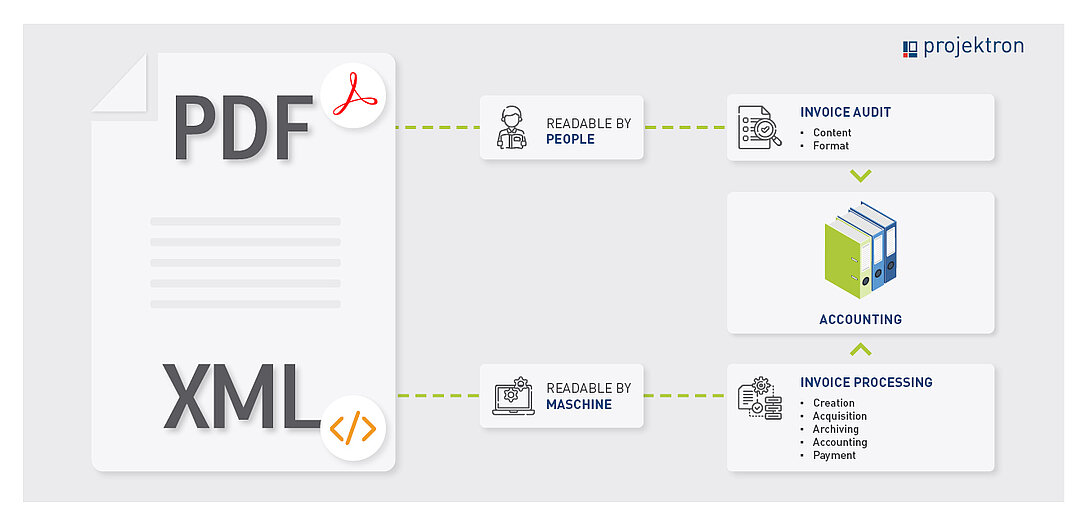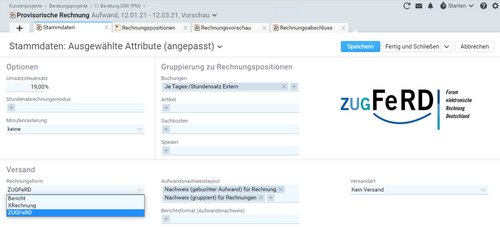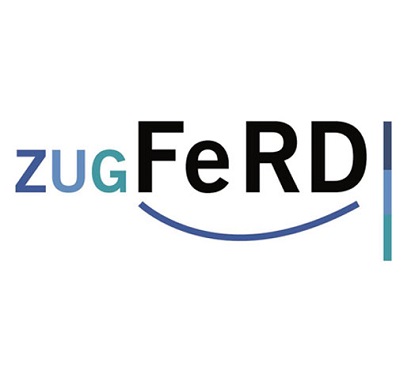06/06/2022 - Articles
ZUGFeRD format: solution for electronic invoicing?
The ZUGFeRD format is a cross-industry data format for electronic invoicing. ZUGFeRD is the abbreviation for "Central User Guide of the Forum Electronic Invoice Germany". There are already clients who only accept ZUGFeRD-compliant invoices. In our technical article, you can learn more about the advantages of the ZUGFeRD data format for e-billing.
What does ZUGFeRD stand for and what is the ZUGFeRD format?
ZUGFeRD is the abbreviation for "Central User Guide of the Electronic Invoice Forum Germany". It is a uniform, hybrid, electronic invoice format that is used in business, but also in public administration.
The ZUGFeRD format is based on
- Directive 2014/55/EU of April 16, 2014, on electronic invoicing for public contracts, and
- European standard EN16931, which was published on June 28, 2017.
In addition, as of version ZUGFeRD 2.0, the ZUGFeRD format takes into account
- the Cross-Industry-Invoice (CII) of UN/CEFACT and
- the ISO standard 19005-3:2012 (PDF/A-3).
The cross-industry data format for electronic invoicing was developed by the Forum elektronische Rechnung Deutschland (FeRD) in cooperation with the German Federal Ministry for Economic Affairs and Energy. As a FeRD member, DATEV also contributed to the development of the standard format. The ZUGFeRD format is a translation of the legal requirements resulting from Directive 2014/55/EU and standard EN 16931. This EU standard defines standards and technical rules for electronic invoicing in Europe to ensure interoperability and regulatory compliance.
As a hybrid data format, ZUGFeRD integrates structured invoice data based on the XML format (Extensible Markup Language) in a PDF document (PDF/A-3). An invoice in ZUGFeRD format is therefore sent as a PDF file (ISO standard PDF/A). This document represents the visual component of the electronic invoice and does not differ visually from a conventional invoice in PDF format. However, the PDF file contains the XML version of the same invoice as an additional piece of content. The PDF version allows visual verification, and the XML version allows electronic processing of the structured invoice data by appropriate software systems.
ZUGFeRD format: advantages at a glance
The ZUGFeRD format enables standardization of invoices, which on the one hand should reduce the susceptibility to errors when creating and processing invoices and on the other hand should significantly increase the processing speed. This automated processing of electronic invoices in ZUGFeRD format requires minimal manual effort, which speeds up processing and payment. Also, the creation of an invoice in ZUGFeRD format does not require any additional effort, provided that the invoicing party uses appropriate software that supports the creation of electronic invoices in ZUGFERD format. Data such as invoice number or invoice amount can be read out in a standardized way and used for further processes of processing directly and without media discontinuity.
The advantages of ZUGFeRD at a glance:
- No need for format agreements between invoice parties
- Minimize susceptibility to errors
- Increase processing speed
- Automation of processing and posting
- Minimization of the effort for processing and payment
The goal of the development of the ZUGFeRD format is to replace the previously often used and not error-free OCR recognition and to enable the further processing of invoice data without media discontinuity.
ZUGFeRD and XInvoice: differences and similarities
Similar to the XInvoice format, the ZUGFeRD format corresponds to a recognized electronic invoice.
Thus, ZUGFeRD represents an alternative to the electronic invoice format XInvoice. In contrast to XInvoice, however, the areas of application of the ZUGFeRD format are more diverse: It is used in business transactions:
- B2B
- B2G (Business to Government)
- B2C
Through the integrated XML, the ZUGFeRD format not only serves the requirements of the electronic invoicing obligation to public sector clients, which has been in effect since November 27, 2020, but also addresses the difficulties of the XInvoice that have arisen in the everyday course of business. The user receives an invoice that has the XML format integrated and yet still remains readable in the regular way using the document image of the PDF. This not only enables the invoicing party and the invoice recipient to check and process the invoice as usual, but also offers a user-friendly solution for external persons such as auditors or tax auditors.
When will the ZUGFeRD format become mandatory?
From 20.11.2020, the public administration made electronic invoices with structured data mandatory. The ZUGFeRD invoice is a format that was developed for this purpose. Leading providers of invoice software or of modern accounting programs already offer ZUGFeRD or will switch to it.
As of 20.11.2020, government institutions, authorities and public companies will no longer accept paper invoices. PDFs generated from Word will also no longer be possible.
In the B2B and B2C context, there is no obligation for electronic invoicing. Many invoices still reach their recipients by mail. However, experts expect that by the mid-2020s, electronic invoices will account for more than 50% of the invoice volume generated worldwide, including in B2B traffic.
Create invoice in ZUGFeRD format: What to consider?
In order for PDF and XML to represent identical multipart content of the same electronic invoice in ZUGFeRD format, the requirements of Section 14 (4) of the German Value Added Tax Act (UStG) must be taken into account.

The tax authorities have not specified any concrete verification obligations or control measures for the process of generating identical multiple items. Therefore, invoice senders and invoice recipients should agree on their own verification mechanisms to ensure the content identity of XML and PDF versions of the same invoice. Also to be noted: The standard format ZUGFeRD does not replace signature verification or the alternative in-house control procedure that electronic invoices require.
In addition to the specific requirements for the ZUGFeRD format and the requirements under Section 14 (4) of the German Turnover Tax Act (UStG), the principles for the proper keeping and storage of books, records, and documents in electronic form and for data access (GoBD) apply. A digital signature is mandatory for e-invoices in ZUGFeRD format.
There is no defined procedure for transmitting a ZUGFeRD invoice. An e-invoicing platform is not required, because PDF/A documents can simply be sent by e-mail.
Store invoice in ZUGFeRD format: What to consider?
As with the creation of invoices in ZUGFeRD format, the principles for the proper keeping and storage of books, records and documents in electronic form and for data access (GoBD) also apply to their storage. Accordingly, electronic commercial or business letters and accounting documents must be stored in the format in which they were received (marg. no. 131). You must therefore also store electronic invoices electronically and ensure that the files are machine-readable (marg. no. 128). In the case of an invoice in ZUGFeRD format, you therefore only need to archive the PDF/A file in an audit-proof manner. Scanning of paper invoices is therefore no longer necessary. Storage as a printout of the PDF alone is not sufficient! The e-mail in which the electronic invoice is delivered does not have to be archived.
The length of time that ZUGFeRD format invoices must be retained is defined by the Value Added Tax Act (§ 14b para. 1 p. 1 UstG). As with other forms of invoice, the retention period for ZUGFeRD format invoices is 10 years.
How do I create an invoice in ZUGFeRD format?
If you want to create an invoice in ZUGFeRD format, you need an appropriate software that is either able to convert an existing invoice into ZUGFeRD format or to output a newly created invoice directly as a ZUGFeRD invoice.
The integration can take place via standard software systems (usually ERP or EDI systems) or your IT department can integrate ZUGFeRD into its individual software independently. Many accounting and ERP software systems already support ZUGFeRD, including Projektron BCS.
With the Invoicing module in BCS, you can create an e-invoice in ZUGFeRD format in no time at all. In the master data of an invoice in the invoice generator, simply select ZUGFeRD from the drop-down menu under the "Shipping" category in the "Invoice form" criterion and BCS automatically generates the invoice ready for shipping in PDF/A-3 format. In combination with the CRM functions in BCS, you can send the generated invoice directly from BCS to your clients without any intermediary work.
The processing of invoices in ZUGFeRD format is now compatible with every common tax and accounting software and, for example, is also easily possible with popular DATEV applications:
- DATEV Enterprise online
- DATEV DMS classic
Saddle up everything: Only ZUGFeRD?
At first glance, this statement may sound tempting. However, hurdles have been discovered in the course of applying the new format. For example, although the first versions of ZUGFeRD met the standards of European norms, they still could not be accepted by public sector customers in Germany. This was partly due to the lack of invoice information, which was required regionally by the administration and could only be covered by XInvoice. However, this has been remedied by various extensions and new versions of the ZUGFeRD format.
A binding update period for ZUGFeRD versions cannot currently be determined. However, it can be assumed that the six-month update period for XInvoice will be closely followed. In close cooperation with the French Forum (Forum National de la Facture Electronique et des Marchés Publics Electroniques), a version of ZugFeRD has been developed that largely corresponds to the French standard Factur-X 1.0. Already since March 24, 2020 and since version 2.1. ZUGFeRD is fully compatible with Factur-X and technically identical. Therefore, it is often referred to as version ZUGFeRD 2.1 / Factur-X 1.0. Since then, both formats also use the identifier Factur-X together. Both formats are suitable for invoice exchange between companies, public administration and consumers. Version ZUGFeRD 2.2 / Factur-X 1.0.06 appeared on 01.03.2022.
However, it remains apparent that these issues are only relevant for invoicing public sector clients in Germany. ZUGFeRD invoices between companies outside the German administration bring unlimited advantages of electronic invoicing and can bring an optimization and reduction of effort of all commercial processes of the accounting office.

Über den Autor
The accounting department of Projektron GmbH creates about 3000 invoices per year. The share of XInvoices and invoices in ZUGFeRD format is growing steadily.










